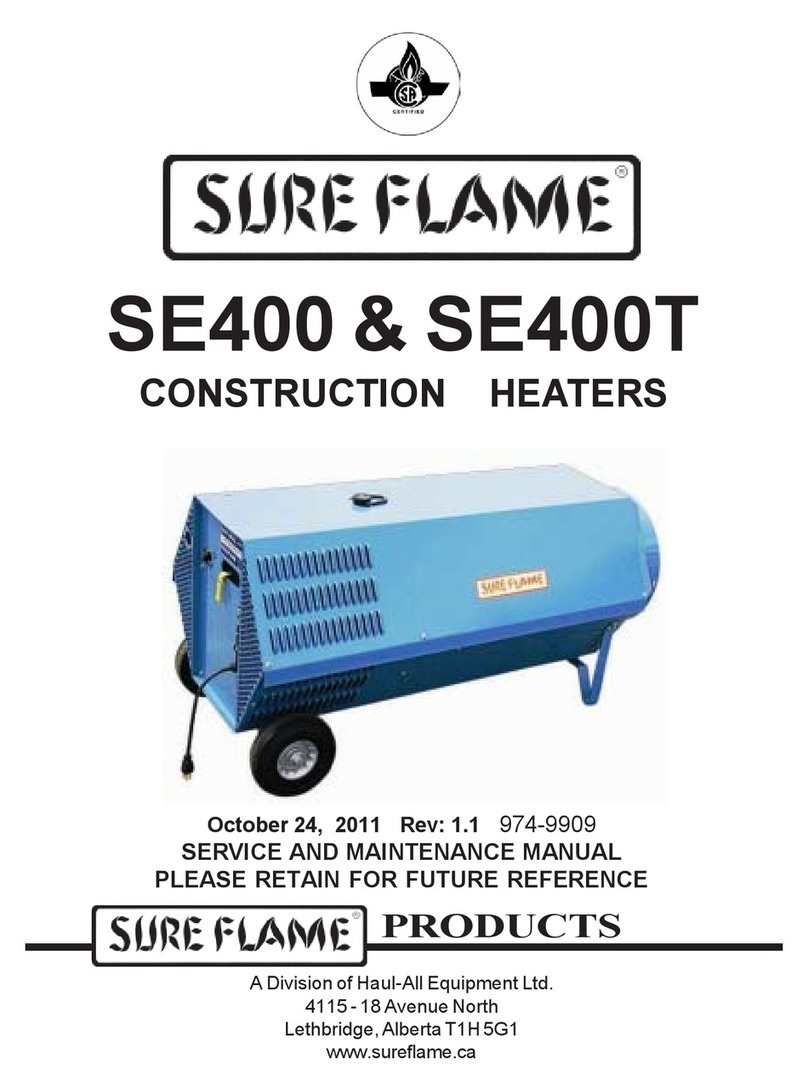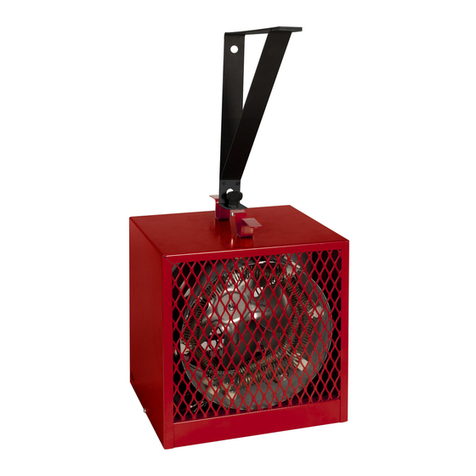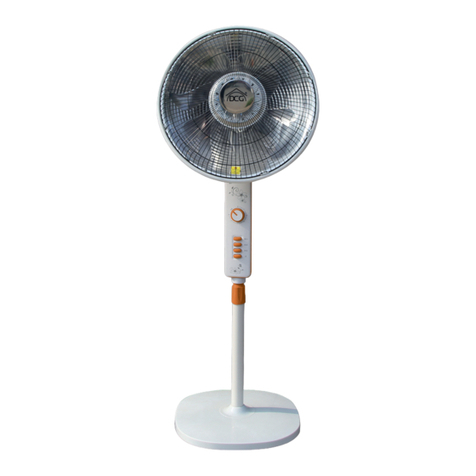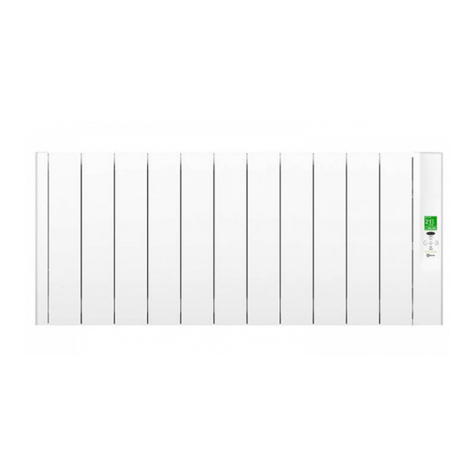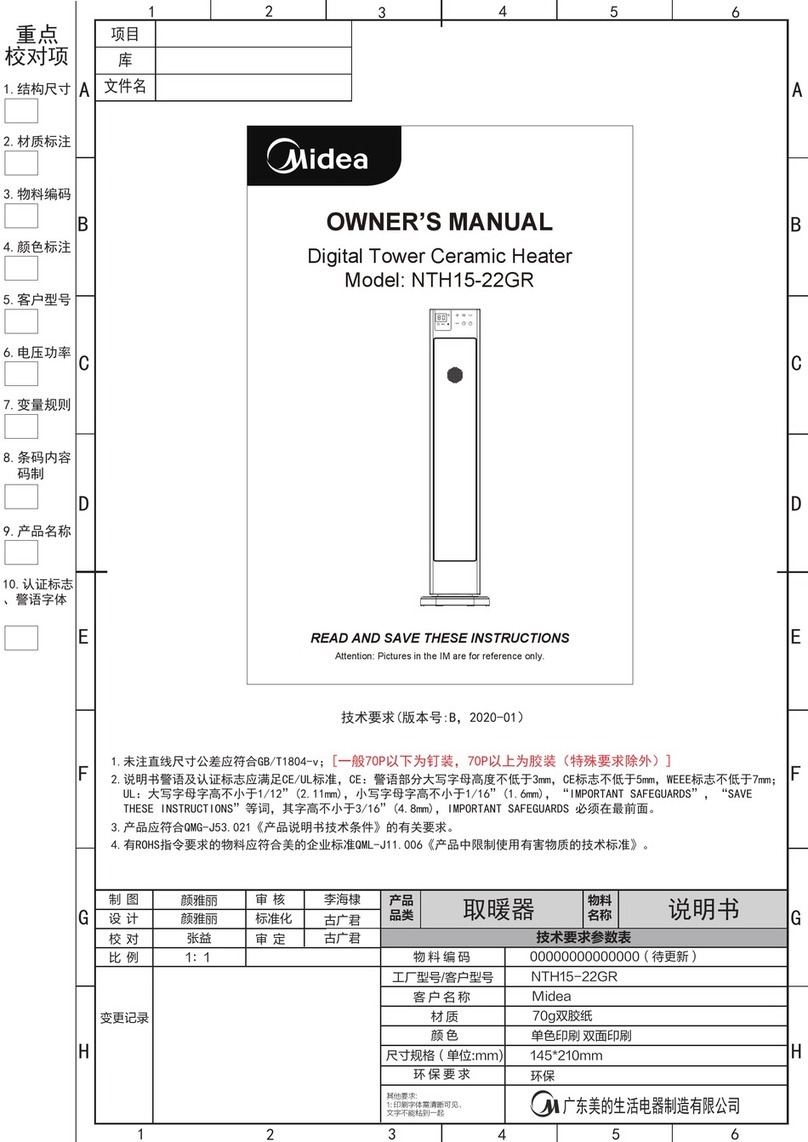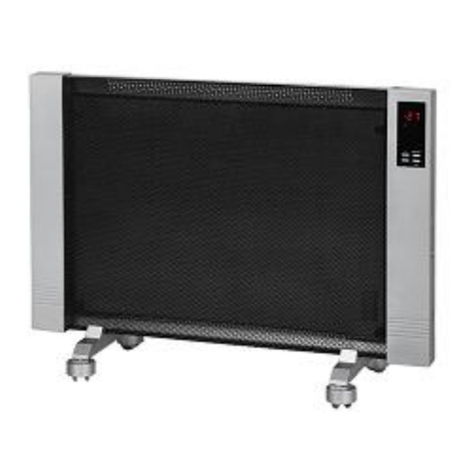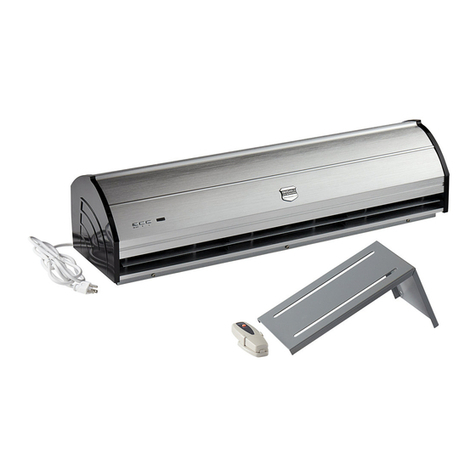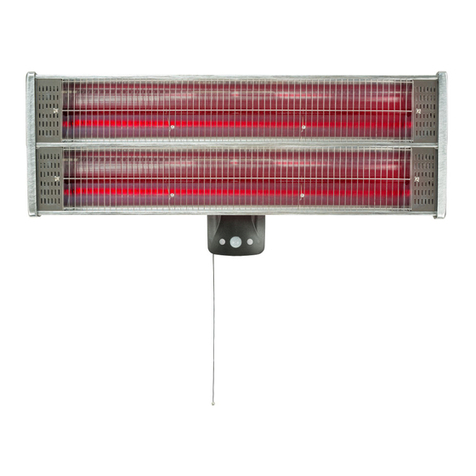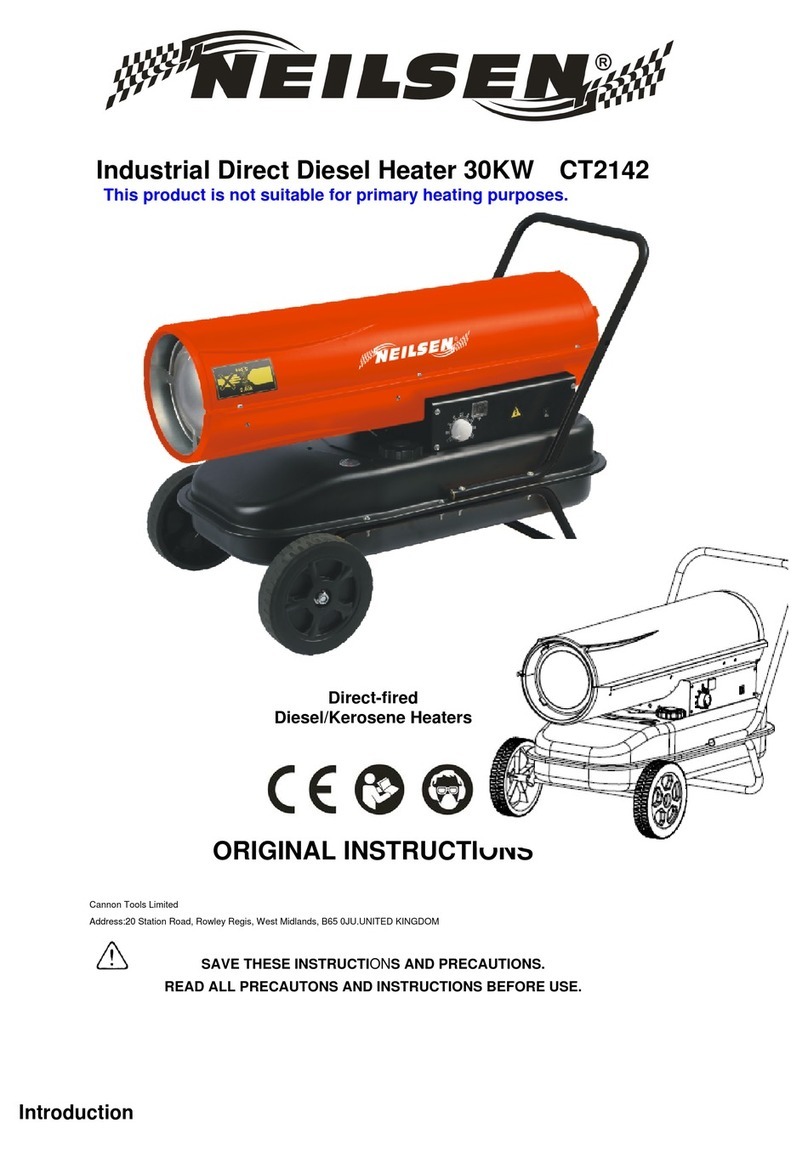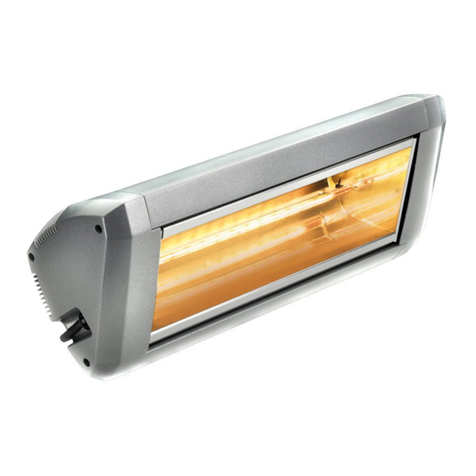Sure Flame ID400 User manual

Model No. ID400
Indirect Construction Heater
Radiateur de construction indirecte
400,000 Btu/h
Retain these instructions for future reference
Veuillez garder ce manuel comme référence ultérieure
Sure Flame Products
A Division of Haul-All Equipment
4115 - 18 Avenue North
Lethbridge, Alberta T1H 5G1
www.sureame.com
Operation and Maintenance Manual
WARNING
Read and follow all installation, and
operating instructions before rst use of this
product
P/N 974-10298
Rev 1.0 Nov 9, 2016
Manuel d’installation et d’entretien
AVERTISSEMENT
Lisez et suivez toutes les installation et les
instructions de fonctionnement avant la
première utilisation de ce produit

2P/N 974-10298 Rev: 1.0
ID400 Operation & Service Manual
Fire, burn, inhalation, and explosion hazard. Keep solid combustibles, such as building
materials, paper or cardboard, a safe distance away from the heater as recommended by the
instructions. Never use the heater in spaces which do or may contain volatile or airborne
combustibles, or products such as gasoline, solvents, paint thinner, dust particles or unknown
chemicals.
WARNING
Failure to comply with the precautions and instructions provided with this heater, can result in
death, serious bodily injury and property loss or damage from hazards of re, explosion, burn,
asphyxiation, carbon monoxide poisoning, and/or electrical shock.
Only persons who can understand and follow the instructions should use or service this heater.
If you need assistance or heater information such as an instruction manual, labels, etc. Contact
the manufacturer.
GENERAL HAZARD WARNING
Le non-respect des mises en garde et des instructions fournies avec ce radiateur peut entraîner la mort,
de graves blessures et des pertes matérielles ou des dommages à la propriété résultant d’un incendie,
d’une explosion, de brulures, d’asphyxie, d’empoisonnement au monoxyde de carbone et/ou d’un choc
électrique.
Seules les personnes aptes à comprendre et à suivre les instructions devraient se servir de ce radiateur
ou le réparer.
Si vous avez besoin d’aide ou d’informations concernant ce radiateur, soit une notice d’instructions,
une étiquette, etc., prière de communiquer avec le fabricant.
MISES EN GARDE GÉNÉRALES
Risque d’incendie, de brûlures, d’inhalation et d’explosion. Garder les combustibles solides, tels les
matériaux de construction, le papier et le carton, à bonne distance de ce radiateur, comme il est recom-
mandé dans les instructions. Ne jamais utiliser cet appareil dans des endroits qui contiennent ou pour-
raient contenir des combustibles volatiles ou en suspension dans l’air tels l’essence, les solvants, les
diluants pour peinture, les particules de poussières ou des produits chimiques inconnus.
AVERTISSEMENT
Ne pas utiliser dans une maison ou un véhicule de camping.
AVERTISSEMENT
Not for home or recreational vehicle use.
WARNING

3
ID400 Operation & Service Manual
P/N 974-10298 Rev: 1.0
Read this Warning First
The Sure Flame Model ID400 is an indirect-
red heater intended to be used primarily
for the temporary heating of buildings under
construction, alteration or repair with or without
ductwork either indoor or outdoor use. Since
the products of combustion are released, it
is imperative that the ue stack is extended
outside of the enclosed area when the heater is
positioned indoors. The ow of supply air and
exhaust gasses must not be obstructed in any
manner.
This heater is not designed as an Unvented Gas
Fired Room Heater under ANSI-Z21.11.2 and
should not be used in the home.
The equipment shall be installed in
accordance with applicable local regulations,
which should be carefully followed in all
cases. In Canada installation shall comply
with CSA B139 Installation Code for Oil
Burning Equipment. In USA installation
shall comply with NFPA 31 Standard for
the Installation of Oil Burning Equipment.
Authorities having jurisdiction should be
consulted before installations are made.
Heater shall be used in accordance with
local and national installation codes and
shall be installed and maintained by a
qualied service person. The heater should
be inspected before each use and at least
annually
We cannot anticipate every use which may be
made for our heaters.
CHECK WITH YOUR LOCAL FIRE SAFETY
AUTHORITY IF YOU HAVE QUESTIONS
ABOUT LOCAL REGULATIONS.
Other standards govern the use of fuel and heat
producing products in specic applications. Your
local authority can advise you about these
Lire cet avertissement en premier
Le modèle Sure Flame ID400 est un chauffage
indirecte destiné à être utilisé principalement
pour le chauffage temporaire de bâtiments en
cours de construction, de modication ou de
réparation avec ou sans réseau de conduits une
utilisation intérieure ou extérieure. Étant donné
que les produits de combustion sont rejetés, il
est impératif que le conduit d’évacuation mène
à l’extérieur de l’espace clos lorsque le radiateur
se trouve à l’intérieur. L’écoulement d’air
d’admission et des gaz de combustion ne doit
en aucune façon être obstrué
Ce radiateur n’est pas conçu comme chauffage
au gaz sans ventilation pour pièce d’habitation
selon la norme ANSI-Z21.11.2 et ne doit pas
être utilisé à domicile.
L’équipement doit être installé conformément
aux réglementations locales, qui devraient
être soigneusement suivies dans tous
les cas. Au Canada l’installation doit se
conformer à la norme CSA B139 Installation
Code for Oil Burning Equipment. Aux
ETATS-UNIS , l’installation doit se conformer
à la norme NFPA 31 Standard for the
Installation of Oil Burning Equipment.
Les autorités compétentes devraient être
consultées avant de procéder à l’installation.
Chauffe-eau doit être utilisé conformément
aux codes d’installation locaux et nationaux,
et doit être installé et maintenu par une
personne qualiée. Le radiateur doit être
inspecté avant chaque utilisation, et au
moins une fois par an.
Nous ne pouvons pas anticiper chaque
utilisation qui pourrait être faite de nos
radiateurs.
VÉRIFIEZ AUPRÈS DE VOTRE AUTORITÉ
LOCALE EN PRÉVENTION DES INCENDIES
SI VOUS AVEZ DES QUESTIONS SUR LES
RÉGLEMENTATIONS LOCALES.
D’autres normes régissent l’utilisation des
carburants et des produits générateurs de
chaleur dans des applications spéciques. Votre
autorité locale peut vous en informer.

4P/N 974-10298 Rev: 1.0
ID400 Operation & Service Manual
Table of Contents
Specications..................................................................................... 5
Installation.......................................................................................... 6
Operating Instructions........................................................................ 9
Maintenance ...................................................................................... 10
Troubleshooting ................................................................................. 15
Wiring Diagrams ................................................................................ 32
Parts Diagrams .................................................................................. 34
Table des matières
Spécications..................................................................................... 5
Installation.......................................................................................... 6
Mode d’emploi.................................................................................... 9
Entretien............................................................................................. 19
Dépannage ........................................................................................ 24
Schémas de câblage ......................................................................... 32
Schémas de pièces............................................................................ 34

5
ID400 Operation & Service Manual
P/N 974-10298 Rev: 1.0
SPECIFICATIONS
Model No. ID400
Capacity / Capacite: Max 400,000 Btu/h (117 kW)
Min 300,000 Btu/h (88 kW)
Fuel / Carburant: # 2 Fuel Oil, Diesel or Kerosene
Maximum Pump Pressure /
Maximum Pression de la pompe:
Minimum Pump Pressure /
Minimum Pression de la pompe: 100 psi (690 kPa)
Nozzle / Gicleur : Delevan 2.25gph 80°W
Electrical Rating / Puissance Electrique: 120 Volts, 11 A, 1Ph, 60Hz
Minimum Temperature / température minimale: -40°C (-40°F)
Duct Diameter / diamètre du conduit: 16” or 2 x 12”
Maximum Flexible Duct Length /
Longueur maximum de conduit souple: 100’ (30.5 m)
Venting: Category I
Flue Diameter / Diamètre de conduit: 8”
Fuel Consumption / consommation de carburant: Max 2.87 gal/hr (10.9 L/hr)
Min 2.15 gal/hr (8.1 L/hr)
Certication / La Certication: CSA B140.0
CSA B140.8
UL 733
Altitude Pressure/Pression
0 - 2000’ 165 psi (1138 kPa)
2500’ 150 psi (1034 kPa)
3000’ 145 psi (1000 kPa)
3500’ 140 psi (965 kPa)
4000’ 135 psi (931 kPa)

6P/N 974-10298 Rev: 1.0
ID400 Operation & Service Manual
Installation
The Sure Flame Model ID400 is an
indirect-red heater intended to be used
primarily for the temporary heating of
buildings under construction, alteration
or repair with or without ductwork
either indoor or outdoor use. Since the
products of combustion are released, it is
imperative that the ue stack is extended
outside of the enclosed area when the
heater is positioned indoors. The ow of
supply air and exhaust gasses must not
be obstructed in any manner.
The equipment shall be installed
in accordance with applicable local
regulations, which should be carefully
followed in all cases. In Canada
installation shall comply with CSA
B139 Installation Code for Oil Burning
Equipment. In USA installation shall
comply with NFPA 31 Standard for the
Installation of Oil Burning Equipment.
Authorities having jurisdiction should be
consulted before installations are made.
Position heater properly on a horizontal
surface before use.
The electrical grounding of the appliance
shall be in compliance with National
Electrical Code, ANSI/NFPA 70, or the
CSA C22.1, Canadian Electrical Code,
Part I
Warning: Heater shall be used in
accordance with local and national
installation codes and shall be installed
and maintained by a qualied service
person. The heater should be inspected
before each use and at least annually.
Warning: Do not use this heater in a
space where gasoline of other liquids with
ammable vapours are stored or used.
Le modèle Sure Flame ID400 est un chauffage
indirecte destiné à être utilisé principalement
pour le chauffage temporaire de bâtiments en
cours de construction, de modication ou de
réparation avec ou sans réseau de conduits
une utilisation intérieure ou extérieure.
Étant donné que les produits de combustion
sont rejetés, il est impératif que le conduit
d’évacuation mène à l’extérieur de l’espace
clos lorsque le radiateur se trouve à l’intérieur.
L’écoulement d’air d’admission et des gaz
de combustion ne doit en aucune façon être
obstrué.
L’équipement doit être installé conformément
aux réglementations locales, qui devraient
être soigneusement suivies dans tous les cas.
Au Canada l’installation doit se conformer
à la norme CSA B139 Installation Code for
Oil Burning Equipment. Aux ETATS-UNIS
, l’installation doit se conformer à la norme
NFPA 31 Standard for the Installation of Oil
Burning Equipment. Les autorités compétentes
devraient être consultées avant de procéder à
l’installation.
Placez le radiateur de façon appropriée, sur une
surface horizontale, avant de l’utiliser.
La mise électrique à la terre de l’appareil se
fera conformément au National Electrical
Code, ANSI/NFPA 70, ou le CSA C22.1, Code
canadien de l’électricité, 1re partie.
Avertissement : Chauffe-eau doit
être utilisé conformément aux codes
d’installation locaux et nationaux, et doit
être installé et maintenu par une personne
qualiée. Le radiateur doit être inspecté
avant chaque utilisation, et au moins une
fois par an.
Avertissement : Ne pas utiliser
le radiateur dans un endroit où on
entrepose ou utilise de l’essence ou
d’autres liquides émanant des vapeurs
inammables.
Installation

7
ID400 Operation & Service Manual
P/N 974-10298 Rev: 1.0
Clearances
Clearance required for combustibles:
Outlet: 10 ft (3 m)
Sides: 2 ft (0.6 m)
Top: 3 ft (0.9 m)
Flue: 18” (45 cm)
Floor: Noncombustible
Minimum clearance required to LP Gas
containers:
Outlet: 20 ft (6.1 m)
Top & Sides: 10 ft (3.0 m)
The heater shall be used in a horizontal
position on a rm, non-combustible surface.
For use with or without ductwork. Only duct-
work supplied by the manufacturer shall be
used with this heater. For either indoor or
outdoor use. Adequate ventilation must be
provided. This heater is for operation at a
temperature rise from 80°C to 140°C (145°F
to 250°F).
Ducting
The ID400 can be ducted on both the inlet
and outlet. The inlet duct can be up to 50’ of
smooth 16” metal duct The outlet duct shall
be of a material able to withstand tempera-
tures of up to 450F. Total outlet duct length
may be up to 300’ of straight, smooth, 16”
metal duct Use of exible ducts, smaller
ducts, or bends in the ducts will reduce the
allowable length and may result in excessive
cycling of the burner.
Dégagements
Espace dégagé requis pour les combustibles:
Sortie: 10 pi (3m)
Cotes: 2 pi (0.6 m)
Desus: 3 pi (0.9 m)
Combustion: 18 po (45 cm)
Plancher: Noncombustible
Espace minimum requis pour les contenants de
Gaz PL
Sortie: 20 pi (6.1 m)
Dessus et Cotes: 10 pi (3.0 m)
Le radiateur devrait être utilisé horizontalement
sur une surface non combustible ferme.
Pour utilisation avec ou sans réseau de gaines.
Seulement réseau de gaines fourni par le fabri-
cant sera utilisé avec cet radiateur. Pour utilisation
à l’intérieur ou à l’extérieur. La ventilation doit être
adéquate. Cet aérotherme fonctionne a une élé-
vation de température de 80°C a 140°C (145°F a
250°F)
Conduits
Le radiateur ID400 peut être canalisé à l’orice
d’entrée et de sortie. La canalisation d’entrée
peut atteindre jusqu’à 50 pieds de conduits en
métal lisse de 16 po. La canalisation de sortie
sera fabriquée d’un matériau pouvant résister
à des températures allant jusqu’à 450 °F. La
longueur totale de la canalisation de sortie peut
atteindre jusqu’à 300 pieds de conduits en métal
lisse droits de 16 po. L’utilisation de conduites
exibles, de plus petites conduites ou de coudes
dans la canalisation réduira la longueur permise
et peut entraîner des uctuations excessives du
brûleur.

8P/N 974-10298 Rev: 1.0
ID400 Operation & Service Manual
Venting
This equipment requires CLASS A venting
to the exterior. The vent connector should
be designed for a negative pressure and be
constructed of materials having corrosion
resistance and durability to heat at least
equivalent to that of No. 24 GSG galvanized
steel.
Venting must comply with CSA B139
Installation Code for Oil Burning Equipment,
NFPA 31 Standard for the Installation of Oil
Burning Equipment, as well as other local
regulations that may apply.
Flue Diameter 8” 6”
Min. vertical height 4’ 4’
Max. lateral length* 15’ 0’
Max. # of added elbows** 2 0
*Lateral lengths must have a minimum 10%
rise.
** A minimum vertical length of 2’ is required
before the rst elbow and after the last
elbow.
Consult the manufacturer for additional
venting options.
Rated ue gas temperature 480°F (250°C)
Rated vent pressure - Negative
Category I
Ventilation
Cet équipement exige une ventilation vers
l’extérieur de type A. Le raccord d’évent
devrait être conçu pour une pression négative
et construit de matériaux ayant une résistance
à la corrosion et une durabilité à la chaleur
équivalant au moins à l’acier galvanisé no 24
GSG.
La ventilation doit être conforme à la norme
CSA B139 Code d’installation
pour l’appareils fonctionnant au mazout,
NFPA 31 Standard pour l’installation de
l’appareils fonctionnant au mazout, ainsi que
d’autres réglementations locales qui peuvent
s’appliquer.
Conduit d’évacuation 8 po 6 po
Hauteur min. verticale 4 pi 4 pi
Longueur max. latérale* 15 pi 0 pi
Nombre max. de coudes** 2 0
*Les longueurs latérales doivent avoir une
inclinaison d’au moins 10 %.
**Une longueur verticale d’au moins 2 pieds
est requise avant le premier coude et après le
dernier coude.
Consulter le fabricant pour des options de
ventilation supplémentaires.
Temperature nominale du gaz de combustion
480°F (250°C)
Pression nominale de l’event - Négative
Catégorie I

9
ID400 Operation & Service Manual
P/N 974-10298 Rev: 1.0
Heater Operating Instructions
1) Ensure the fuel valve (manual valve connecting fuel line) is turned “ON”
(counterclockwise).
2) Connect Power: Use appropriate power supply as indicated by the ELECTRICAL
RATING information.
3) Press and release START switch. START light will come on. Set thermostat to desired
setting. Burner Blower will start. Flame will ignite after another 30 seconds.
4) If the burner does not ignite the red pushbutton will light up. Press the reset button to
clear the red light and try again. Depending on the error, the reset button may have to
be held for 15 seconds before the red light will clear. If after several tries it still does not
start, prime the pump.
5) Heater will switch between high ame and no ame as required to maintain the desired
temperature.
6) To stop, press STOP. Burner blower will stop after about 60 seconds. Main blower will
continue to cycle until heat exchanger has cooled.
Mode d’emploi do radiateur
1) Assurez-vous que la vanne de carburant (vanne manuelle raccordée à la conduite de
carburant) est activée (dans le sens contraire des aiguilles d’une montre).
2) Brancher le courant électrique - se servir d’une source l’alimentation équivalente à la
PUISSANCE ELECTRIQUE indiquée ci-haut.
3) Enfoncer et relâcher le sélecteur START. Le témoin START s’allumera. Régler le
thermostat à la température désirée. La soufante du brûleur va démarrer. Puis la amme
s’allumera 30 secondes plus tard.
4) Si le brûleur ne se déclenche pas, le bouton-poussoir rouge s’allumera. Appuyer sur
le bouton de réinitialisation pour éteindre le témoin rouge et réessayer. Selon l’erreur, il se
peut qu’on doive appuyer sur le bouton de réinitialisation pendant 15 secondes avant que
le témoin rouge s’éteigne. Amorcer la pompe si le brûleur ne se déclenche toujours pas
après plusieurs tentatives.
5) Le radiateur commutera entre amme haute et amme absente, selon les besoins,
pour maintenir la température sélectionnée.
6) Pour éteindre, enfoncer STOP.
La soufante s’arrêtera environ 60 secondes plus tard. La soufante principale continuera de
cycler jusqu’àl’échangeur de chaleur se refroidit.

10 P/N 974-10298 Rev: 1.0
ID400 Operation & Service Manual
Maintenance
Warning: Disconnect electrical supply before servicing.
Weekly:
Air ow Remove any obstructions to air ow
Monthly:
Cords and Connectors Check for cracks, exposed wires, and dirt in electrical connectors
Physical Integrity Check for damage to body, louvers, and inlet screens that may obstruct
air ow and impact combustion quality
Belts Replace belt if cracked or worn according to details below.
Ensure belt tensioner is in place and tensioner roller is running smoothly.
End of Season:
Combustion Chamber Remove burner assembly
Clean inside of combustion chamber with a wire brush.
Vacuum all ash and soot from combustion chamber.
Inspect combustion chamber for any damage.
Do not use a heater that has a hole in the combustion chamber.
Burner/Nozzle/Igniter Remove burner from burner assembly.
Clean burner and igniter with solvent or emery cloth. Inspect for cracked
ceramic. Clean cad cell.
Replace Nozzle (see below).
Clean Igniter (see below).
Inspect wires for cracks or evidence of overheating.
Ensure gasket and door seal are in place and not damaged.
Electrical
components*
Check all wiring for loose, cracked, or overheated wires and connectors.
Replace if necessary.
Ensure ground wires are properly connected.
Ensure control box seal is in place and not damaged.
Clean cooling system using dry air.
Check the rotation condition of the cooling fan.
Fuel pump and lter Verify that pump pressure matches the specication label.
Adjust pump pressure if necessary (see below).
Inspect fuel lter and clean if necessary (see below).
Impellers Remove any dirt build-up on both burner and blower impellers.
Inspect impellers for loose or damaged ns.
Run heater and check for vibration.
Replace impellers that are damaged or causing vibration.
Body Ensure all panels and shields are in place and that fasteners are tight.
* Before servicing, disconnect power supply.

11
ID400 Operation & Service Manual
P/N 974-10298 Rev: 1.0
SETTING FAN LIMIT SWITCHES
The fan limit switch is factory set and should not normally need to be adjusted. If it is out of
adjustment, follow these procedures:
To set pointers, hold dial securely with one hand and move the pointers with the other hand
using “limit stop tool”. Do not force the pointers past any stops on the dial even though the
dial may be graduated beyond the stops.
Front Limit
Move the right hand pointer so that its high side of lever indicates 250°F.
Front Fan
Move the “Fan On” pointer so that its high side of lever indicates 90°F. This is the
temperature at which the blower will start. Move the “Fan Off” pointer so that its high side of
adjustable lever indicates 70°F. This is the temperature at which the blower will stop.
Side Limit
Move the right hand pointer so that its high side of lever indicates 270°F.
Side Fan
Move the “Fan On” pointer so that its high side of lever indicates 90°F. This is the
temperature at which the blower will start. Move the “Fan Off” pointer so that its high side of
xed lever indicates 70°F. This is the temperature at which the blower will stop.
ADJUSTABLE
LIMIT STOP
FAN ON SET
REMOVE
BRASS
JUMPER
FAN OFF SET
TO RELEASE
WIRE, PUSH
SCREWDRIVER
IN AND PULL
WIRE OUT

12 P/N 974-10298 Rev: 1.0
ID400 Operation & Service Manual
Replacing Belts:
Warning: Disconnect power before servicing belts.
The main blower uses a double belt transmission. It requires the belts to be paired, and
both need to be changed at the same time. Ensure that the blower belt tensioner is in place
and set at 25°-30°, and that the tensioner roller is running smoothly. Replace if worn.
Adjusting Pump Pressure:
Install pressure gauge in the gauge port on top of the pump (see pump label) using
1/8NPTF extension. While pump is operating, verify that the pressure is steady and it is in
specied parameters accordingly to altitude the heater is in service (see the specication
label on the heater or in manual). If the pressure differs from specications, re-adjust using
screwdriver (adjusting port is on right hand side of the pump).
Remove the pressure gauge and securely tighten the gauge port. Check for leakage.
Priming the Pump
1. Prepare the burner for priming by attaching a clear plastic hose over the bleed port tting
and fully opening the pump bleed port. Use a suitable container to collect purged oil.
2. Initiate a call for heat.
3. After the burner starts, press and hold the reset button for 15 seconds until the yellow light
turns on. This indicates that the button has been held long enough.
4. Release the reset button. The yellow light will turn off and the burner will start up again.
5. At burner start up, click the reset button while the igniter is still on. This will transition the
control to a dedicated Pump Prime mode, during which the motor, igniter, and valve are
powered for four minutes. The yellow light will be on.
6. Bleed the pump until all froth and bubbles are purged. If desired, terminate the call for
heat or hold the reset button for at least one second to exit Pump Prime mode and return
to Standby.
7. At the end of 4 minutes, the yellow light will turn off and the control will automatically return
to standby mode.
8. If prime is not established during the four minute pump prime mode, return to step 5 to re-
enter Pump Prime mode. Repeat steps 5 through 7 until the pump is fully primed and the
oil is free of bubbles.
9. Terminate the call for heat, and the control will resume normal operation.
Filter Maintenance:
To drain any water collected in the lter, remove the plug at the bottom of the bowl. Ensure
gasket is in place when replacing plug.
To clean the lter, remove bolt on top of the lter head (use 13mm wrench). Remove the
screen from the bowl and clean it using kerosene. Clean the bowl. When reassembling the
lter, ensure that all seals including the O-ring in the lter head are in place.

13
ID400 Operation & Service Manual
P/N 974-10298 Rev: 1.0
Burner Maintenance:
Accessing the burner:
1. Disconnect power supply to heater
2. Disconnect the electrical connection on the pump solenoid
3. Remove 2 nuts on either side of burner blower
4. Slide burner assembly out of the heater until it reaches the end of the rail, then allow
the assembly to drop down, raising the burner head to a vertical position.
Cleaning the burner:
Clean the turbulator using emery cloth or steel wool. Clean the photo cell using a soft cloth
and rubbing alcohol.
Replacing the Nozzle:
1. Disconnect cables from ignitor
2. Loosen the 2 set screws on the turbulator using 5/64” Allen wrench
3. Slide the turbulator off of the nozzle adapter
4. Unscrew the nozzle from the nozzle adapter
5. Replace using the nozzle listed in the heater specications.
6. When reassembling, ensure that the nozzle is tight, that the turbulator is fully
inserted onto the nozzle adapter, that the set screws are tight, and that the ignitor
cables are reconnected.
Ignitor Maintenance:
Remove ignitor from turbulator by removing 2 screws. Clean ceramic and igniter rods using
emery cloth. Verify the ignition electrode gap and orientation as per the following drawing.
The ignitor ceramic is easily broken. Use extreme care if attempting to readjust the ignitor
gap or orientation.
Igniter Gap Igniter Position
.20
`
.01
.25 +.01
-.01
.524
.130 +.050
-.000

14 P/N 974-10298 Rev: 1.0
ID400 Operation & Service Manual
Basic Function
When the heater power switch is turned on, the heater will rst ensure that the control box is warm enough. If not, it will turn
on the control box heater and the yellow warmup light will come on. The warm up period is at most 15 minutes. As long as
the heater remains powered it will not have to go through the warmup period again.
Pressing the green button puts the heater into standby mode (the green light will be on). When the thermostat (or thermostat
jumper) calls for heat, the burner blower will start. After 30 seconds the burner will ignite. Once the heat exchanger warms
up the main blower will start. Both the burner and main blower will cycle to maintain a proper outlet temperature.
If the burner does not ignite the red pushbutton will light up. Press the reset button to clear the red light and try again.
Depending on the error, the reset button may have to be held for 15 seconds before the red light will clear. If after several
tries it still does not start, prime the pump.
If the heater loses its ame after igniting, it will try to ignite 2 more times with a 60 second delay between retries. After that it
will go into a lockout and the reset button will need to be pressed.
A solid green light indicates that the heater is working normally. A ashing green light indicates that the heater has recovered
from an error, and the number of ashes indicates the type of error.
Either a solid or ashing red light indicates that the heater has encountered an error and is not functioning. The combination
of lights and number of ashes can be used to diagnose the problem.
A solid yellow light indicates that the heater is in warmup mode. A ashing yellow light indicates an abnormal function but not
an error that will shut down the heater.
Heater Troubleshooting

15
ID400 Operation & Service Manual
P/N 974-10298 Rev: 1.0
Green
light
Red light Flame control code Symptom Possible Problem Solution
Red Green Yellow
OFF OFF OFF OFF OFF
No power at heater a) Defecve plug
b) Defecve receptacle
c) Defecve extension cord
d) Wiring issues
e) No power at source
a) Replace plug or plug & cord
b) Replace receptacle
c) Replace extension cord
d) Fix wiring
e) Connect to a matching power
source
Heater will not start when green push
button depressed
a) Defecve start push buon (will
not make contact)
b) Defecve stop push buon
(will not make contact)
a) Replace start buon
b) Replace stop buon
OFF or
ON OFF OFF OFF OFF
- Main blower runs connuously
from the moment the heater is
plugged in;
- Main blower runs connuously
long aer there was no more call
for heat.
a) Defecve blower control switch
(front &/or side)
b) Man/auto buon on fan limit
switch set on manual (front &/
or side)
c) Room temperature above the
minimum seng of the blower
control switch (front &/or side)
d) Blower motor contactor always
on
a) Replace fan limit switch
b) Set man/auto buon on fan limit
switch on automac (front &/or side)
c) Lower room temperature or lower fan
o sengs below room temperature
d) Replace contactor
OFF OFF OFF ON OFF Heater will start when start push button
is depressed
Green light LED defective
(Start Push Button)
Replace Green LED
ON OFF OFF OFF OFF
If call for heat signal is received by
ignition controller, the burner will not
start ( the heater will be on standby for
an indenite amount of time)
Defective burner limit switch (side
fan limit switch) NC contact open all
the time
Replace side fan limit switch
ON OFF OFF OFF OFF
Heater will not start when green push
button depressed (thermostat set to
“High”)
Defective thermostat (never calls for
heat)
Replace:
- thermostat or
- Defecve thermostat cord assembly
or
- Defecve thermostat extension cord
assembly
Heater will not start when green push
button depressed (Thermostat jumper
installed)
Defective jumper (never calls for heat) Replace defective thermostat jumper
ON ON OFF OFF OFF Heater running properly Alarm module defective Replace Alarm module

16 P/N 974-10298 Rev: 1.0
ID400 Operation & Service Manual
Green
light
Red light Flame control code Symptom Possible Problem Solution
Red Green Yellow
ON
(briey)* OFF N.A. N.A. N.A.
a) Logic relay will not get energized
when start push buon is de-
pressed
b) The heater will blow the breaker
when start push buon is de-
pressed
c) The relay does get energized when
start push buon is depressed but
gets de energized when start push
buon is return to normal state
a) Defective logic relay coil (in-
terrupted coil)
b) Defecve logic relay coil
(shorted coil)
c) Defecve NO contact
(always o)
Replace logic Relay
ON Unknown Unknown Unknown Unknown
No reaction from the burner after call
for heat
Defective ignition controller Replace ignition controller
ON OFF OFF ON OFF
Heater will start when start push button is
depressed (thermostat set to “NO Heat”)
Defective thermostat (always on) Replace thermostat
Heater will start immediately after being
plugged in (the heater will stop after
depressing the stop button but it will start
again after stop push button is return to
normal state)
Defective start push button (will not
break contact
Replace start button
Heater will start immediately after being
plugged in (the green light will turn off
after depressing the stop button but the
heater will stop)
Defective NO contact (always on) Replace logic Relay
Heater will not stop when red push
button depressed
Defective stop push button
(will not break contact)
Replace stop button
ON OFF OFF ON/
ashing
OFF/
ashing
If the heater overheats due to low air
ow through the exchanger or the burner
being over red the burner will turn of
and eventually cycle (event triggered by
outlet limit switch)
Defective burner limit switch (side
fan limit switch) NC contact will not
open
Replace side fan limit switch

17
ID400 Operation & Service Manual
P/N 974-10298 Rev: 1.0
Green
light
Red light Flame control code Symptom Possible Problem Solution
Red Green Yellow
ON ON
ON/
ashing
***
OFF OFF
Burner fails and ame controller enters
“Soft Lockout”
Burned out 2A fuse Replace fuse
Burner fails and ame controller enters
“Soft Lockout”
a) Defecve air switch or wrong
seng
b) Air switch circuit failure
a) Replace or adjust air switch
b) Fix wiring issue
Burner fails and ame controller enters
“Soft Lockout”
This could cause the fuse to burn out;
please see “Burned out 2A fuse” paragraph.
a) Defecve solenoid (interrupted
coil).
b) Defecve solenoid (short circuit
in the coil)
a) Replace solenoid
b) Replace solenoid &/or Replace fuse
a) Burner fails and ame controller
enters “So Lockout”
b) This could cause the fuse to burn
out; please see “Burned out 2A
fuse” paragraph.
a) Defecve lter heater (interrupted
electric element)
b) Defecve lter heater (short
circuit in electric element)
a) Replace Heated lter
b) Replace Heated lter &/or Replace
fuse
Burner fails and ame controller enters
“Soft Lockout”
Defective solenoid plug or cord Replace cord
Burner fails and ame controller enters
“Soft Lockout”
a) Defecve burner motor
b) Defecve or loose impeller
a) Replace burner motor
b) Use setscrew to secure impeller to
motor sha
ON ON
ON/
ashing
***
OFF OFF
a) Burner fails and ame controller
enters “So Lockout”
b) Burner unstable or fails and ame
controller enters “So Lockout”
(Bubbles or froth in ger loop)
c) Burner unstable or fails and ame
controller enters “So Lockout”
(Bubbles or froth in ger loop)
a) Defecve fuel pump (seized)
b) Vacuum leak (defecve oil line
or connecon
c) Defecve Tiger-loop; defecve
oater or cracked body.
a) Replace fuel pump
b) Fix defecve oil line or connecon
c) Replace Tiger-loop
Burner fails in function Dirty or defective CAD cell Clean or replace the photo cell
Fan does not start
Humming noise
a) Defecve burner motor
b) Burner motor thermal overload
tripped
c) Burner motor thermal overload
defecve
a) Replace motor
b) Reset burner motor thermal overload
c) Replace burner motor thermal
overload
Burner failure but no red light alarm showing Alarm module defective Replace Alarm module
Burner fails and ame controller enters
“Soft Lockout”
Defective burner limit switch (front fan
limit switch) NC contact open all the time
Replace front fan limit switch

18 P/N 974-10298 Rev: 1.0
ID400 Operation & Service Manual
Green
light
Red light Flame control code Symptom Possible Problem Solution
Red Green Yellow
ON ON
ON/
Solid
****
or
ashing
***
OFF OFF
Burner fails and ame controller enters
“Soft Lockout/Hard Lockout”
(it will cycle on outlet limit switch)
Outlet limit switch defective Replace outlet limit switch
Burner fails and ame controller enters
“Soft Lockout/Hard Lockout”
(it will cycle on outlet limit switch)
Defective burner limit switch (front fan
limit switch) NC contact will not open
Replace front fan limit switch
Burner fails and ame controller enters
“Soft Lockout/Hard Lockout”
Defective ignition transformer Replace ignition transformer
Burner fails and ame controller enters
“Soft Lockout/Hard Lockout”
a) Igniter insulaon failure
b) Ignitor posion
c) Igniter gap
a) Replace igniter
b) Adjust posion
c) Adjust Gap
Burner fails and ame controller enters
“Soft Lockout/Hard Lockout”
Defective ignition cables or
disconnected
Reconnect ignition cables or Replace
ignition cable
Burner fails and ame controller enters
“Soft Lockout/Hard Lockout”
Fusible Safety shut-off valve (closed
or fused)
Turn Safety shut-off valve ON or replace
the fusible hand wheel (silver 165°F)
ON ON
ON/
Solid
****
OFF OFF
No reaction from the burner after call for
heat (Error light ON)
Defective ignition controller Replace ignition controller
Burner fails at start up Defective CAD cell a) Clean the photo cell or
b) Replace the photo cell
Fan does not turn Main blower bearings seized Replace main blower
Fan does not turn Broken belt Replace belt
Fan does not turn or turns too slow Broken tensioner Replace belt tensioner
a) Fan does not turn
b) Fan does not turn
a) Blower motor contactor does
not get energized
b) Blower motor contactor does
get energized but contacts
remain o
Replace contactor
Fan does not turn or turns too slow:
heater is overheating
Slipping belt Adjust belt tensioner to the appropriate tension
recommended by the belt manufacturer
Motor is overloading: heater is
overheating
Belt too tight Adjust belt tensioner to the appropriate tension
recommended by the belt manufacturer
*The ”Start” push button green light turns on and stays on for as long as the push button is depressed.
** Call for heat: thermostat connected to heater and set to Heat or Thermostat jumper installed (Ignition controller Terminals TR and TW jumped).
***To reset error press ignition controller red button >1 seconds
****To reset error press ignition controller red button 15+ seconds

19
ID400 Operation & Service Manual
P/N 974-10298 Rev: 1.0
Entretien
Avertissement : Débrancher fournitures électriques avant l’entretien.
Toutes les semaines :
Débit d’air Retirer les obstructions à la circulation de l’air
Roulements Lubrier les roulements selon les détails ci-dessous
Tous les mois :
Cordons et
connecteurs
Vérier s’il y a des ssures, des câbles à découvert et de la saleté dans les
connecteurs électriques
Intégrité physique Vérier s’il y a des dommages au corps, aux louvres et grilles d’entrée qui
peuvent entraver la circulation de l’air et avoir une incidence sur la qualité de la
combustion
Courroie Remplacer la courroie si elle est fendue ou usée.
S’assurer que le tendeur de courroie est en place et que le rouleau tendeur
fonctionne en douceur.
Fin de la saison :
Chambre de
combustion
Retirer l’ensemble de brûleur.
Nettoyer l’intérieur de la chambre de combustion à l’aide d’une brosse
métallique. Enlever toute les cendres et la suie de la chambre de combustion à
l’aide d’un aspirateur.
Vérier s’il y a des dommages à la chambre de combustion. Ne pas utiliser un
radiateur ayant un trou dans la chambre de combustion.
Brûleur/Gicleur Retirer le brûleur de l’ensemble de brûleur.
Nettoyer brûleur et l’allumeur avec du solvant ou de la toile émeri. Vérier s’il
y a des ssures dans la céramique. Nettoyage cellule cao. Vérier s’il y a des
ssures ou des signes d’excès de chaleur dans les câbles (voir ci-dessous).
Remplacer l’injecteur (voir ci-dessous).
S’assurer que le joint d’étanchéité et le joint d’étanchéité de la porte sont en
place et ne sont pas endommagés.
Éléments
électriques*
Vérier s’il y a des câbles et des connecteurs desserrés, ssurés ou ayant des
signes d’excès de chaleur. Les remplacer, au besoin. S’assurer que les ls de
mise à la terre sont bien raccordés. S’assurer que le joint d’étanchéité de la
boîte des commandes est en place et n’est pas endommagé. Vérier la rotation
condition du ventilateur de refroidissement.
Pompe à
carburant et du
ltre
Vérier que la pression de la pompe correspond à l’étiquette de spécications.
Régler la pression du régulateur, au besoin (voir ci-dessous).
Inspecter la crépine et la nettoyer, au besoin (voir ci-dessous).
Rouets
centrifuges
Enlever l’accumulation de saleté sur le brûleur et les rouets centrifuges du
ventilateur.
Vérier si les pales des rouets centrifuges sont desserrées ou endommagées.
Faire fonctionner le radiateur et vérier s’il y a des vibrations.
Remplacer les rouets centrifuges qui sont endommagés ou qui causent des
vibrations.
Corps S’assurer que tous les panneaux et tous les écrans sont en place et que les
attaches sont bien serrées.
* Avant de procéder à l’entretien, débrancher l’alimentation électrique et s’assurer que la puissance
est acquitté en vériant qu’il n’y a pas de tension entre les bornes R et T sur le VFD.

20 P/N 974-10298 Rev: 1.0
ID400 Operation & Service Manual
RÉGLAGE DU CADRAN
Le commutateur de limite du ventilateur est réglée en usine et ne devrait normalement pas besoin
d’être ajustés. Si elle est hors d’ajustement, suivez ces procédures:
Pour régler les repères, maintenir le cadran fermement en place avec une main et déplacer les
repères avec “limiteur butée outil”. Ne pas forcer les repères au-delà des butées du cadran, même
s’il y a des graduations sur le cadran au-delà des butées.
Haut Limite
Déplacer le repère droit pour que son bord droit indique 200°F pour le haut commutateur de limite.
Haut Ventilateur
Déplacer le repère central de marche du ventilateur (Fan On) pour que son côté haut du levier
indique 100°F. C’est la température à laquelle le surpresseur démarre. Déplacer le repère gauche
d’arrêt du ventilateur (Fan Off) pour que son côté haut du levier indique 90°F. C’est le température
qui le ventilateur sera arrêté.
Côté limite
Déplacer l’aiguille de droite jusqu’à ce que son côté haut du levier indique 250°F.
Ventilateur latéral
Déplacez le “Fan ON” pointeur an que son côté haut du levier indique 100° F. C’est la température
à laquelle le surpresseur démarre.
Déplacer le “Fan Off” pointeur an que son côté haut du levier indique 90° F. C’est la température à
laquelle le surpresseur s’arrête.
RÉGLAGE D’ARRÊT
DE LA BUTÉE
INDICATEUR DE MARCHE
DU VENTILATEUR
RETIREZ EN LAITON
LE CAVALIER
INDICATEUR D’ARRÊT
DU VENTILATEUR
POUR LIBÉRER
LE CÂBLE, POUSSER
UN TOURNEVIS ET
RETIRER LE FIL
Table of contents
Languages:
Other Sure Flame Heater manuals
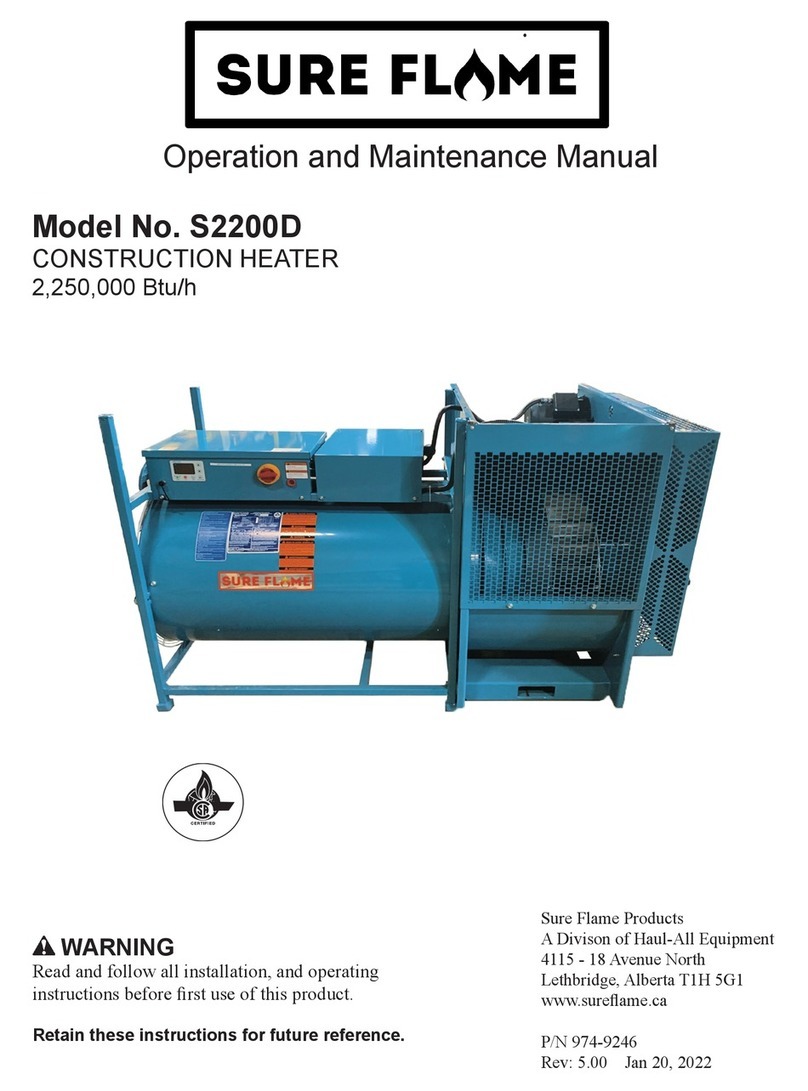
Sure Flame
Sure Flame S2200D User manual

Sure Flame
Sure Flame SE405 Installation and user guide
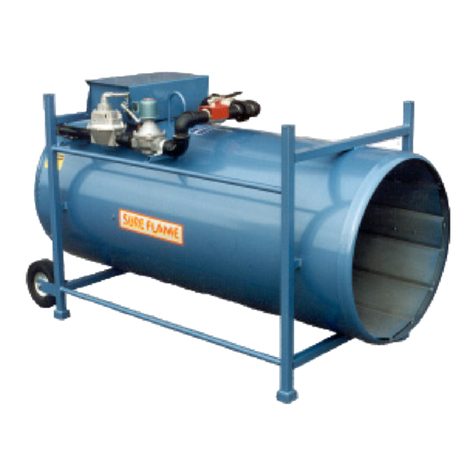
Sure Flame
Sure Flame SL11E User manual
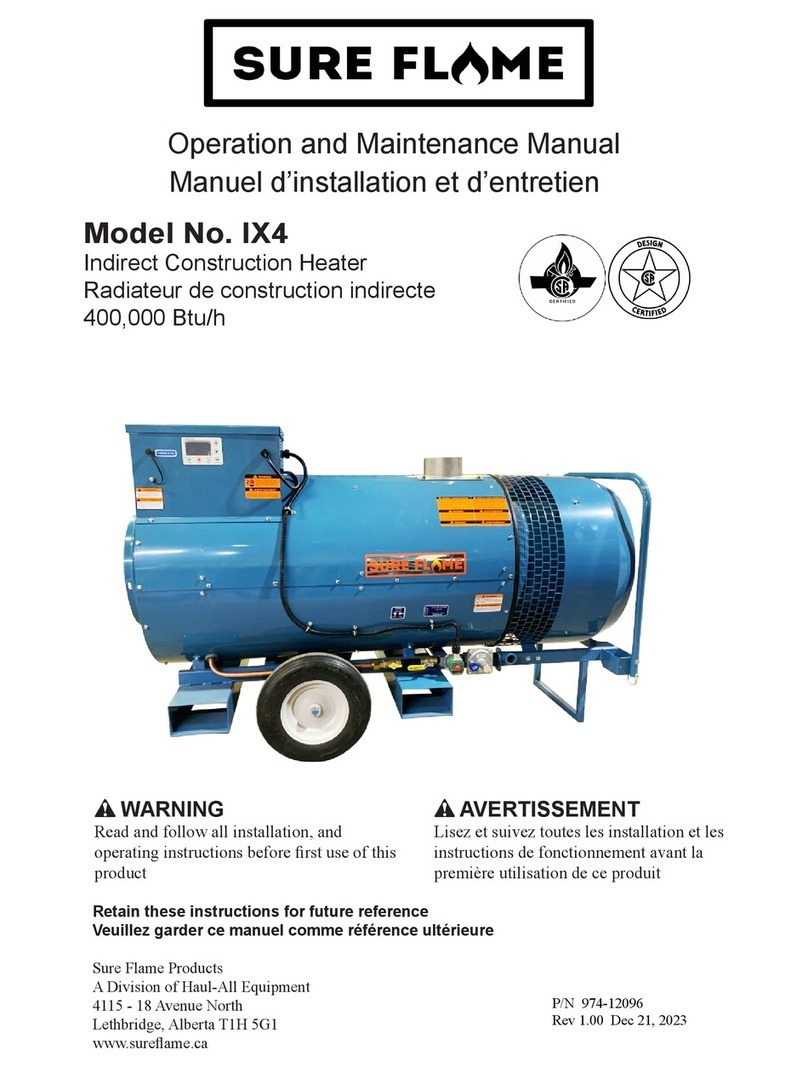
Sure Flame
Sure Flame IX4 User manual
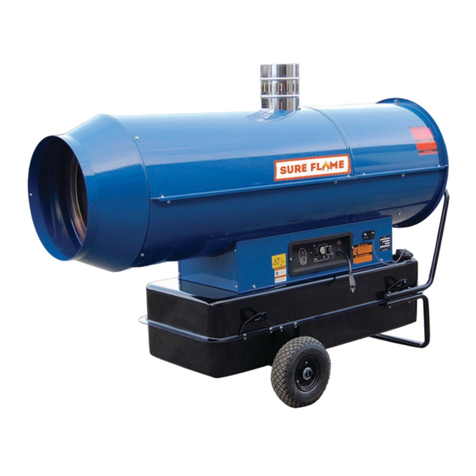
Sure Flame
Sure Flame ID 100 User manual

Sure Flame
Sure Flame IX800 User manual

Sure Flame
Sure Flame S1505B User manual
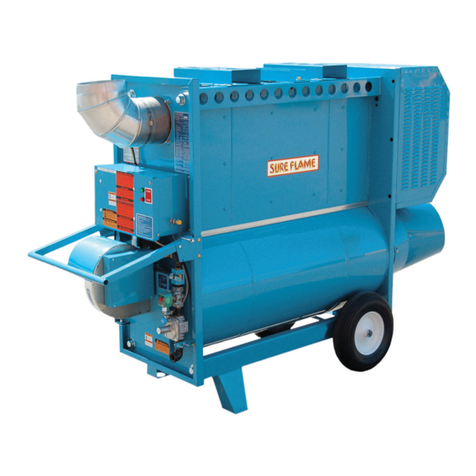
Sure Flame
Sure Flame IX405 User manual

Sure Flame
Sure Flame S400 Installation and user guide
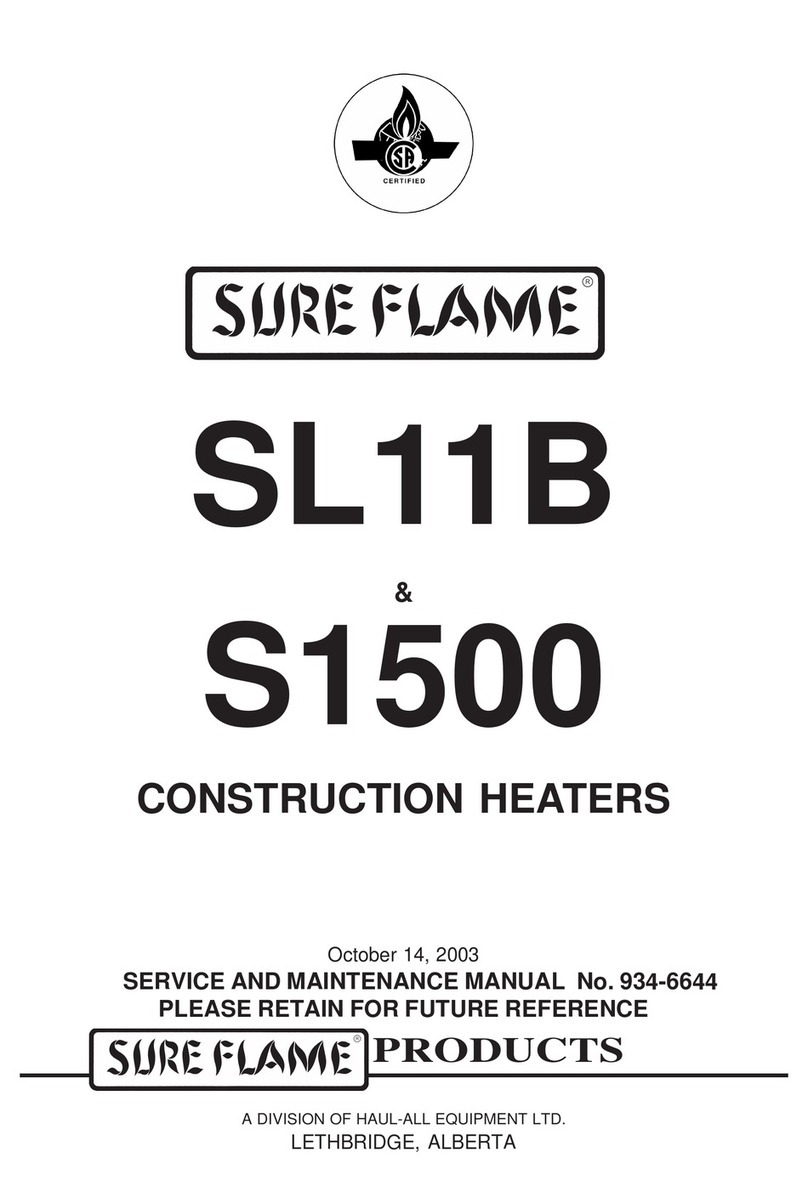
Sure Flame
Sure Flame SL11B Installation and user guide
